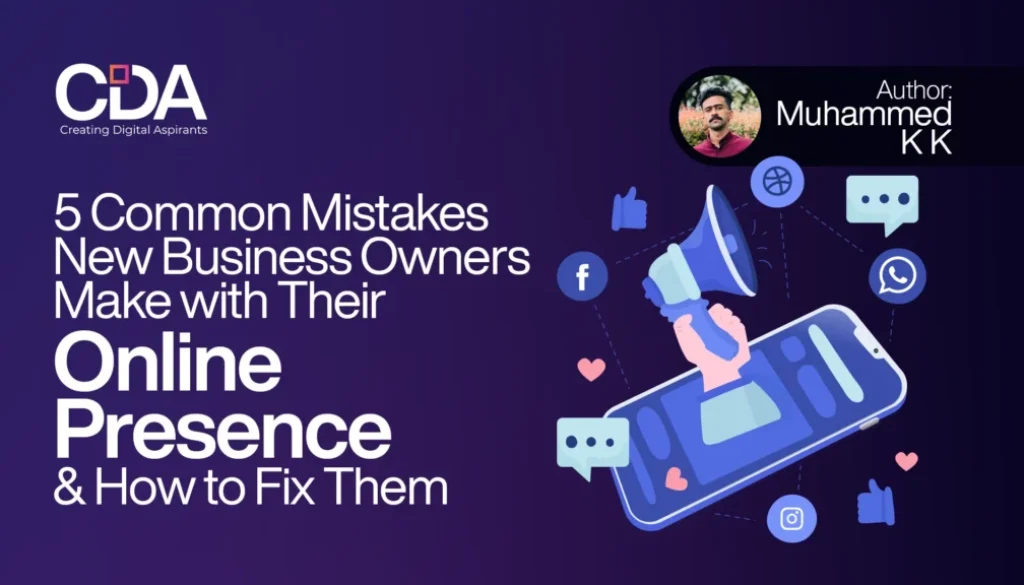5 Common Mistakes New Business Owners Make with Their Online Presence and How to Fix Them
In today’s digital era, having a robust online presence is crucial for new business owners. A well-executed online strategy not only enhances visibility but also builds credibility and drives sales. However, the path to establishing a powerful online presence is fraught with potential pitfalls. This article addresses five common mistakes new business owners make, providing insights into how to avoid them.
Table of Contents

Mistake 1: Inadequate Website Design
A website is often the first point of contact between a business and potential customers. An inadequately designed website can deter visitors, affecting the business’s growth and reputation.
Ignoring Mobile Optimization
With the majority of internet users accessing websites through mobile devices, a mobile-friendly design is no longer optional. Mobile optimization ensures your site is accessible and user-friendly on smartphones and tablets. A site that isn’t optimized for mobile can frustrate users, causing high bounce rates. For instance, a local restaurant with a non-responsive website may lose potential customers who are on the go and looking for a quick dining option.
Complicated Navigation
An intuitive and straightforward navigation system helps visitors find the information they need without hassle. Complicated menus or poorly structured navigation can confuse and frustrate users, driving them away. Imagine visiting a website to book a hotel room and struggling to find the booking page due to excessive dropdown menus or hidden links; this is a sure way to lose a potential booking.
Slow Load Times
In the fast-paced digital world, speed is vital. Websites that take too long to load can lead to increased bounce rates. Research shows that a delay of just one second in page load time can result in a 7% reduction in conversions. A business owner must ensure that their website is optimized for speed by compressing images, leveraging browser caching, and minimizing code.
Poor User Experience (UX)
User Experience (UX) encompasses all aspects of a visitor’s interaction with your website. A website with poor UX can drive away customers before they have a chance to explore your offerings. This includes issues such as unreadable fonts, clashing colors, or intrusive pop-ups. Providing a seamless and enjoyable experience encourages users to stay longer and engage more thoroughly with your site.
Mistake 2: Neglecting Search Engine Optimization (SEO)
SEO is the practice of optimizing your website to rank higher in search engine results, thus increasing organic traffic. Neglecting SEO can significantly hinder your online visibility.
Lack of Keyword Research
Keyword research is the foundation of effective SEO. It involves identifying the words and phrases that potential customers are using to search for products or services like yours. Without thorough keyword research, you risk targeting the wrong terms, which can result in poor search engine rankings and low-quality traffic. Tools like Google Keyword Planner or Ahrefs can help in finding relevant keywords.
Ignoring On-Page SEO
On-page SEO refers to the optimization of individual web pages to rank higher and earn more relevant traffic. This includes optimizing title tags, meta descriptions, headers, and content for targeted keywords. For example, a blog post about “Tips for Healthy Eating” should have the keyword phrase “healthy eating tips” strategically placed in the title, headers, and body content.
Overlooking Local SEO
For businesses serving local customers, local SEO is essential. This involves optimizing your website to appear in local search results. This can be achieved by claiming your Google My Business listing, getting reviews, and ensuring your NAP (Name, Address, Phone number) information is consistent across the web. For instance, a local florist should focus on appearing in search results when someone searches “florist near me.”
Failing to Monitor and Adjust SEO Strategies
SEO is an ongoing process. It is important to monitor your website’s performance using tools like Google Analytics and make necessary adjustments. This includes tracking keyword rankings, analyzing traffic sources, and understanding user behavior. A static SEO strategy can result in stagnant results; regular updates and tweaks ensure continued growth in organic traffic.
Mistake 3: Ineffective Social Media Strategy
Social media platforms provide a huge opportunity to connect with potential customers. An ineffective social media strategy can result in missed opportunities and wasted resources.
Not Knowing the Target Audience
Understanding your target audience is critical when crafting a social media strategy. Different demographics prefer different platforms and types of content. For instance, if you’re a freelancer offering digital marketing services in Kozhikode, using LinkedIn to share professional insights might be more effective than focusing only on Instagram, which caters to a younger demographic with visual content.
Inconsistent Posting Schedule
Consistency is key in social media marketing. Posting irregularly can result in poor engagement and reduced visibility. Creating a content calendar can help maintain a consistent posting schedule. Tools like Buffer or Hootsuite can assist in scheduling posts in advance, ensuring regular activity on your social media channels.
Overlooking Engagement
Social media is not just about broadcasting your message but also about engaging with your audience. Responding to comments, participating in discussions, and showing appreciation for your followers’ support can build a loyal community. An auto-reply for messages or a generic response can cause your audience to feel ignored or undervalued.
Focusing on Too Many Platforms
Trying to maintain an active presence on too many social media platforms can dilute your efforts and result in subpar performance. It’s better to focus on a few platforms where your target audience is most active and invest in quality content and genuine engagement on those platforms.

Mistake 4: Poor Content Marketing
Content is king in the digital marketing realm. Poor content marketing can lead to ineffective communication with your audience and lower retention rates.
Lack of a Content Plan
A content marketing plan outlines your content goals, target audience, and the types of content you will create. Without a plan, your content efforts can become disjointed and aimless. An editorial calendar helps organize content creation and ensures that your content aligns with your overall marketing strategy.
Not Providing Valuable Information
Content should provide real value to your audience. This includes solving problems, answering questions, and providing insights. For example, a blog post titled “How to Improve Your Website’s SEO” should offer practical tips and actionable advice rather than just vague suggestions.
Ignoring Visual Content
Visual content such as images, videos, and infographics can significantly enhance engagement. A blog post with relevant images or a how-to video can make content more digestible and appealing, leading to higher engagement rates. Businesses should invest in creating high-quality visual content that complements their written content.
Fail to Update and Repurpose Old Content
Updating old content ensures that it remains relevant and accurate. Repurposing content involves taking existing content and transforming it into different formats, such as turning a blog post into a video or an infographic. This increases the lifespan and reach of your content without constantly creating new material.
Mistake 5: Not Tracking and Analyzing Performance
Monitoring and analyzing performance is essential to understanding the effectiveness of your online strategies. Neglecting this can lead to missed opportunities and ineffective campaigns.
Ignoring Analytics Tools
Analytics tools such as Google Analytics provide valuable insights into your website’s performance. These tools help track metrics such as traffic, bounce rate, and conversion rates. Ignoring these tools can leave you in the dark about how your website is performing.
Not Setting Clear KPIs
Key Performance Indicators (KPIs) are measurable values that help track the success of your campaigns. Without clear KPIs, it’s difficult to gauge whether your efforts are paying off. For instance, a KPI for an online store could be the conversion rate, while a KPI for a blog could be the average time spent on the page.
Failing to Adjust Based on Data
Data-driven decisions are crucial for effective online strategies. Failing to adjust your strategies based on data can result in continued poor performance. Regularly reviewing analytics data and making necessary changes ensures your strategies are always optimized for the best results.
Overlooking Customer Feedback
Customer feedback is a goldmine of insights. Ignoring feedback can result in missed opportunities for improvement. Encourage customers to leave reviews, take surveys, or provide feedback through social media. Use this feedback to make improvements and better meet your customers’ needs.
Conclusion
Addressing these common mistakes can significantly improve your online presence. Ensuring an adequate website design, implementing effective SEO strategies, crafting a targeted social media strategy, delivering valuable content, and consistently tracking and analyzing performance are crucial steps for success. New business owners should regularly review and refine their online strategies to stay competitive and drive growth.
Author Info
Muhammed K K, a Freelance Digital Marketer in Kozhikode Kerala
Learner of CDA Digital Marketing Training in Kochi




